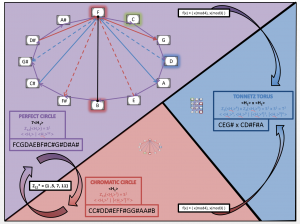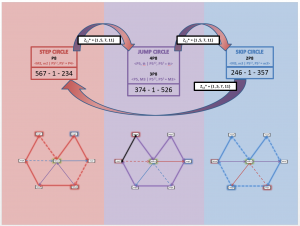
Inspired by the book Visual Group Theory, KCM has all the rigor of any other mathematical or musical theory. But ultimately what sets this theory apart is that it is a visual theory in which math and musical principle are best expressed through pictures and diagrams, not staff notation or equations. Thus, “If you can draw it, you can play it!” becomes an important mantra in all things KCM.
Some of more important visuals include:
-The Major Accidental Network
-Jump-Skip Space
-The Little Wheel
Wiki on Category Theory for Now
“Category theory[1] formalizes mathematical structure and its concepts in terms of a collection of objects and of arrows (also called morphisms). A categoryhas two basic properties: the ability to compose the arrows associatively and the existence of an identity arrow for each object. Category theory can be used to formalize concepts of other high-level abstractions such as sets, rings, and groups.”
Here is a listing of conventional categories.
Here is a listing of KCM Categories.
Outline personal perspective of CT
Outline Usage in KCM
Statment on adherence to mathematical constructs.
Statement on belief that KCM is necessary and sufficient

FCGDAEB comes from the Fifth encoding (circle of fifths), not Second encoding (chromatic scale).
FCGDAEB becomes CEGBDFA becomes CDEFGAB becomes FCGDAEB through successive applications of the Z12 automorphic generator, it’s multiplicative groups Z*12 = {1,5,7,11}

